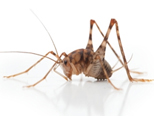
Problems with Camel Crickets are entirely controllable under professional care. Our treatment goal is to stop a problem at its source so it doesn’t keep coming back. Using state-of-the art equipment and methods, our licensed exterminators will inspect your home’s environment and construction to identify the problem and determine the best course of action. Contact us today!
Camel Crickets are attracted to cool, moist, and humid areas in and around our homes. This cricket often invades storage buildings, crawlspaces, basements, garages and indoor areas where moisture is presents such as in a basement or laundry room. It’s normally just a nuisance pest, but they can damage stored items, such as garments and linens packed in boxes. They tend to become a problem when we have extremes in weather conditions, such as extended rains or periods of hot, and dry weather.
There are several species of crickets that have a humpbacked appearance and are referred to as camel crickets, they do not chirp (field crickets chirp) and have no wings. Their long legs give them a spider-like appearance. They are brownish in color up to two inches long in body and 4 inches for the legs.
The bodies of baby crickets may appear translucent. They may instinctively jump towards a perceived threat in an intimidating manor but they don’t bite, have poor eyesight, and are not harmful.
Camel crickets are typically found in moist areas including under logs and stones, or in stacked firewood. Areas that are overgrown with vegetation such as ivy and other ground covers provide excellent hiding places. In early spring, adult females begin to lay eggs in the soil. A few weeks later, the nymphs hatch from these eggs.
As with most other pest, effective control of Camel Crickets is a multi-stepped process.
It starts with eliminating harborage sites and reducing conditions that are conducive or attractive to these pests. Examine your home or building for holes or access areas to the outside.
If used, pesticides should focus on outdoor barrier treatments. Sprays can be very effective applied to foundation walls, around vents, crawlspace accesses, basement doors and windows. Indoors, common household (indoor) insecticides can be applied to baseboards, and areas behind appliances. Follow all directions on the packaging. However, please note that if you follow the steps outlined earlier for excluding these pests, the need for indoor applications should be reduced.